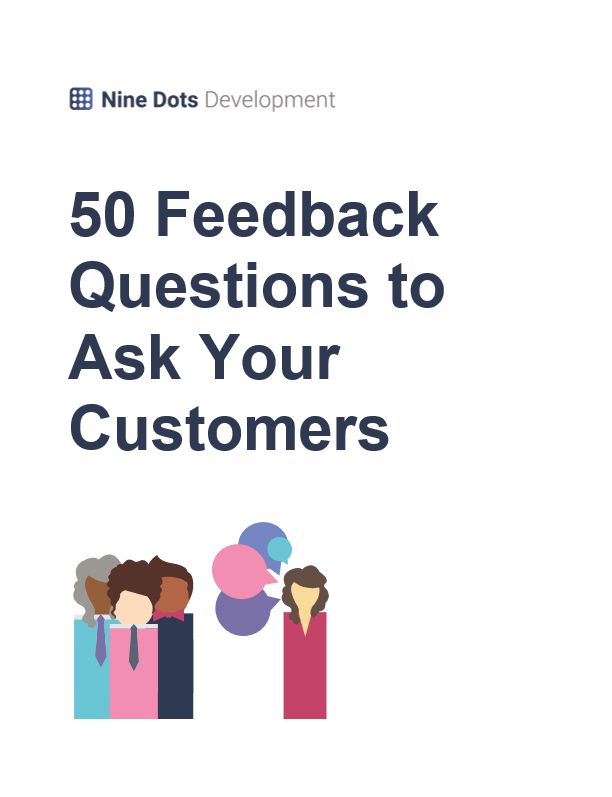Monday 06 Sep 2021 Article
The TakeawayHow Do You Know if You’re Truly Delighting Your Customers?
Delighting Your Customers
Part 1 of 2
#Sales #CustomerService #DelightingYourCustomers #PersonalDevelopment
The perfectly matched resource for this article...
Download 50 Questions to Ask Your Customers!
Knowing where to start with collecting feedback can be challenging so we have collated 50 Feedback Questions to Ask Your Customers, which you can download below.
Download!Playing catchup?
How Do You Know if You’re Truly Delighting Your Customers?
Ask yourself: is my organisation’s revenue based on just good sales and marketing, or do we truly delight our customers with our products, services, and customer experience?
Whilst sales and marketing will initially get you customers, delighting existing customers is the key to retaining those customers, building your brand reputation, and generally having a successful business long term.
The secret to knowing if you’re delighting your customers is through feedback - but how do you get valuable feedback effectively?
In today’s article, we will be talking about why feedback matters, key metrics you should keep an eye on, and how to get truly valuable feedback.
Why Feedback is Key
Put simply, feedback identifies what you’re doing well so that you can keep doing it, and highlights what you’re doing not so well so that you can improve in those areas.
This insight is invaluable to businesses - we have experienced undeniable benefits from collecting feedback ourselves here at Nine Dots.
At Nine Dots, we transitioned from a private training provider to an approved, registered apprenticeship provider and with this, we are now subject to external judges of our quality e.g. Ofsted, ESFA - this has meant that we have had to put an even bigger focus on feedback, which has led to a far better business To ensure that the quality of our services is as high as possible, we take different types of feedback for almost every interaction we have with our learners. This feedback is taken electronically and feeds directly into our dashboard and our live feedback feed page on our website. Collecting this feedback has given us a mountain of data which we review every month, comparing it to previous feedback, to identify how we have improved since the last review, and what else we can do to improve further - there will always be room for improvement.
Action taken, which is derived through the feedback you collect, helps you build a ‘moat’ around your business. This moat, made up of constant improvement, acts as a metaphorical barrier to entry, making it harder and harder for your competition to steal your customers.
Being able to tell if you’re delighting your boss, staff, or colleagues is also vital. You can give and get feedback to your peers in many different ways, including:
- 1-1s
- 360 feedback
- Appraisals
This article focuses more on getting feedback around your business but if personal feedback is something you’re interested in, you can click here to read one of our previous articles all about ‘Transforming Feedback Fear Into Appreciation’.
{{ADVERT}}
How Else Can You Measure Customer Satisfaction?
The traditional way of getting feedback is by asking customers to score your products/services out of 5 on different criterias, but there are many other metrics you could look at, including:
- Sales
How many sales are you making?
Looking at the number of sales you are making and any trends to suggest if sales are on the incline/decline is a good indicator of whether your offering is appealing to your target market. - Repeat Business
Do your customers buy from your business again and again?
Having repeat customers signals that they were so delighted by your product/service and found it that valuable that they want to buy again. - Number of Referrals
How often do you hear “somebody I know recommended your business to me” from your customers?
Referrals and recommendations are one of the best indicators that you are truly delighting your customers
How to Get Truly Valuable Feedback
There are two main types of feedback: closed and open.
- Closed feedback limits responses to a certain number of options. While this can be good to get statistical data, it often leaves out important details. This can be used for quantitative analysis.
- Open feedback, for example asking customers “how do you believe we could improve our services?”, elicits a longer, more detailed - and therefore more useful - response. This is used for qualitative analysis.

While measuring sales, repeat business, and referrals is a good starting point, they are examples of closed feedback - this should be the bare minimum. There are many other ways to get truly valuable feedback, such as:
- Talking to clients to get anecdotal feedback
- Using mystery shoppers
- Implementing focus groups
- Completing a customer walk-through experience to get a first-hand perspective
- Sending out open-ended questionnaires
For some industries, like ours, it’s easy to be put off collecting feedback as there are a lot of moving parts to the service we provide, making it challenging to analyse the effectiveness of every part. However, neglecting to collect, analyse, and act on feedback is costly, so it is well worth the time and effort.
50 Feedback Questions to Ask Your Customers
One of the easiest, quickest-to-implement, ways of getting valuable feedback is to simply ask for feedback from your existing customers.
Knowing where to start can be challenging so we have collated 50 Feedback Questions to Ask Your Customers, which you can download by clicking here.
Ultimately, businesses need to be constantly evolving, innovating, and improving, or else competitors will beat them to it.
---
Until next time...
Download 50 Questions to Ask Your Customers!
Knowing where to start with collecting feedback can be challenging so we have collated 50 Feedback Questions to Ask Your Customers, which you can download below.
Download!Missed an article?
More from Delighting Your Customers
